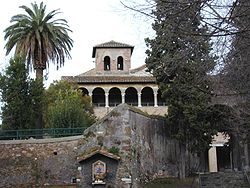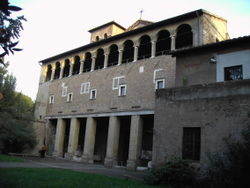.gif)
San Saba (Rome)
Encyclopedia

Basilica
The Latin word basilica , was originally used to describe a Roman public building, usually located in the forum of a Roman town. Public basilicas began to appear in Hellenistic cities in the 2nd century BC.The term was also applied to buildings used for religious purposes...
church in
Churches of Rome
There are more than 900 churches in Rome. Most, but not all, of these are Roman Catholic, with some notable Roman Catholic Marian churches.The first churches of Rome originated in places where Christians met. They were divided into three categories:...
Rome
Rome
Rome is the capital of Italy and the country's largest and most populated city and comune, with over 2.7 million residents in . The city is located in the central-western portion of the Italian Peninsula, on the Tiber River within the Lazio region of Italy.Rome's history spans two and a half...
, Italy. It lies on the so-called Piccolo Aventino, which is an area close to the ancient Aurelian Walls
Aurelian Walls
The Aurelian Walls is a line of city walls built between 271 and 275 in Rome, Italy, during the reign of the Roman Emperors Aurelian and Probus....
next to the Aventine and Caelian Hill
Caelian Hill
The Caelian Hill is one of the famous Seven Hills of Rome. Under reign of Tullus Hostilius, the entire population of Alba Longa was forcibly resettled on the Caelian Hill...
.
The current Cardinal Deacon of the Titulus S. Sabae is Jorge Medina Estévez
Jorge Medina Estévez
Jorge Arturo Agustín Medina Estévez is a Chilean Cardinal of the Roman Catholic Church. He was Cardinal Protodeacon until February 23, 2007, and is Prefect Emeritus of the Congregation for Divine Worship and the Discipline of the Sacraments.-Early life and ordination:Medina was born in Santiago in...
. The titulus was established in 1959.
History
According to legend, St. Silvia, mother of Pope Gregory IPope Gregory I
Pope Gregory I , better known in English as Gregory the Great, was pope from 3 September 590 until his death...
, had an estate at the site. After her death, so legend reads, her estate was transformed into an affiliate monastery of St. Andreas, the monastery which Gregory I founded at the site of today's San Gregorio al Celio. This legend can be traced back to have originated from the 12th century, when in context of Renovatio Romae and Church Reform, the monastery of San Saba was meant to be provided with a long and local tradition.

Palestine
Palestine is a conventional name, among others, used to describe the geographic region between the Mediterranean Sea and the Jordan River, and various adjoining lands....
) who had fled their home country after the Islamic invasion, came to Rome to attend the Lateran council. After the council, these Sabaite monks settled down in an old domus, or noble estate, on the "Piccolo Aventino", which at this time was deserted due to the big decrease in Rome's population numbers. Here, they founded an eremitic cell. The Sabaites introduced the cult of St. Sabas to Rome. In ancient sources, their monastery however goes by the name cellas novas, "cellanovas" or "cellaenovae", which is in reference to the "cellae" of their mother closter, Mar Saba.
The Sabaite monastery prospered soon and for long. In the 8th and 9th century, San Saba was one of the most prestigious of Rome and among the leading "Greek" monasteries. Its received rich papal donations. Since 680, its abbots held important diplomatic roles in the relationships between Rome and Byzantium
Byzantium
Byzantium was an ancient Greek city, founded by Greek colonists from Megara in 667 BC and named after their king Byzas . The name Byzantium is a Latinization of the original name Byzantion...
, and represented the Roman Church and Pope at several church councils in Constantinople.
In 768
768
Year 768 was a leap year starting on Friday of the Julian calendar. The denomination 768 for this year has been used since the early medieval period, when the Anno Domini calendar era became the prevalent method in Europe for naming years.- Europe :* Pepin the Short , king of the Franks since...
, Antipope Constantine II
Antipope Constantine II
Antipope Constantine II was an antipope in 767 and 768.He was born in Nepi near Viterbo, a scion, along with his three brothers, of noble Roman family....
was held prisoner in this monastery, before being killed by the Lombards
Lombards
The Lombards , also referred to as Longobards, were a Germanic tribe of Scandinavian origin, who from 568 to 774 ruled a Kingdom in Italy...
.
The Benedictine of Monte Cassino
Monte Cassino
Monte Cassino is a rocky hill about southeast of Rome, Italy, c. to the west of the town of Cassino and altitude. St. Benedict of Nursia established his first monastery, the source of the Benedictine Order, here around 529. It was the site of Battle of Monte Cassino in 1944...
received the church after its rebuild in the 10th century. After many years of decay, it was completely renovated in the 13th century, after the church was granted to the Cluniac monks. The church was granted to the Cistercians in the 15th century before going to the Society of Jesus
Society of Jesus
The Society of Jesus is a Catholic male religious order that follows the teachings of the Catholic Church. The members are called Jesuits, and are also known colloquially as "God's Army" and as "The Company," these being references to founder Ignatius of Loyola's military background and a...
.
Structure
The church, preceded by a small porch from the 13th century, has a nave with two aisles. These end with three apses. The interior is characterized by numerous interventions from different ages. The columns are from ancient buildings, and the floor is an example of CosmatesqueCosmatesque
Cosmatesque, or Cosmati, is a style of geometric decorative inlay stonework typical of Medieval Italy, and especially of Rome and its surroundings. It was used most extensively for the decoration of church floors, but was also used to decorate church walls, pulpits, and bishop's thrones...
marble art from the beginning of the 13th century. The main artpieces are the notable frescoes in a room on the left side of the church, the so-called fourth nave: they portrays the miracles of St. Nicholas.
The crypt, built on the house of St. Silvia, holds the relics of St. Sabas. The sacristy houses also a fragment of fresco from the very first church (8th year).

